|
Miles Magister
British Trainer
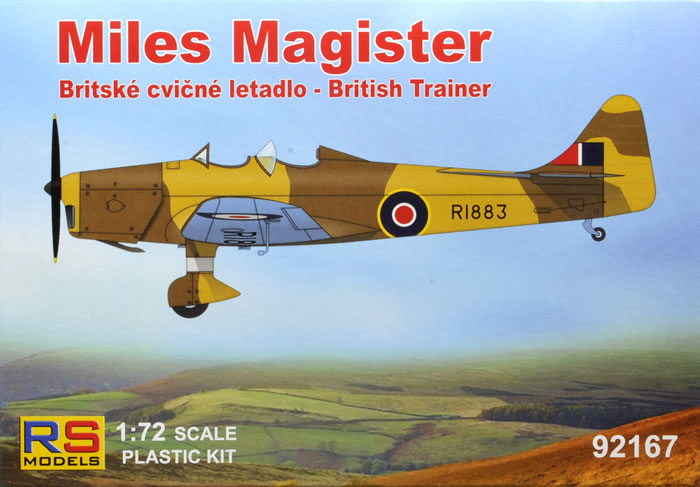
RS Models, 1/72 scale
S u m m a r y : |
Catalogue Number: |
RS Models Kit No. 92167 – Miles Magister – British Trainer |
Scale: |
1/72 |
Contents & Media |
36 grey plastic parts; one PE fret of sixteen parts; one clear film; with decals for four subjects. |
Price: |
Available on-line from these stockists:
|
Review Type: |
First Look |
Advantages: |
A huge advance over the old Frog kit, very nice detail, good quality decals. |
Disadvantages: |
The single-seat decal option requires some scratch-building as the kit does not include the part required. |
Conclusions: |
This is a good quality limited run kit with some very nice surface detail.
The components are nicely rendered and assembly is generally well catered for by the instructions, although the underwing pitot’s location could be made easier to discern than it is.
The option of single-seater is nice to have, but the inclusion of a cockpit blanking plate would have been nice, or at least a template to help make one should have been included Single-seater gripes aside, this is a delightful kit of the Miles Magister, and highly recommended.
|
Reviewed by Mark Davies

RS Models 1/72 scale Miles Magister is available online from Squadron.com
Background
The Miles M.14 Magister was a British two-seat monoplane basic trainer aircraft built by the Miles Aircraft for the Royal Air Force and Fleet Air Arm. Affectionately known as the Maggie, the Magister was based on Miles' civilian Hawk Major and Hawk Trainer and was the first monoplane designed specifically as a trainer for the RAF. As a low-wing monoplane, it was an ideal introduction to the Spitfire and Hurricane for new pilots.
The Miles M.14 was designed to meet Air Ministry Specification T.40/36 and was first flown on 20 March 1937 by F.G. Miles and then christened 'Magister'. Early Magisters (including the first prototype) suffered a number of accidents when the aircraft could not be recovered from a spin. To solve this problem, the tailplane was raised by 6 inches (15 cm), anti-spin strakes fitted to the rear fuselage, and eventually, a new taller rudder. Thus modified, the aircraft became the definitive M.14A.
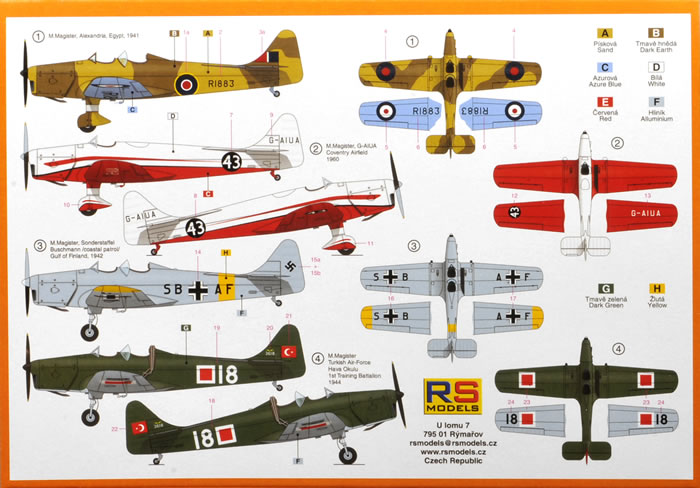
Production began in October 1937 and by the start of the Second World War over 700 Magisters had entered service with RAF Elementary Flying Training Schools, eventually equipping 16 such schools as well as the Central Flying School. Large numbers of civilian Hawk Majors were also pressed into service as trainers. Production of the Magister continued until 1941 by which time 1,203 had been built by Miles and an additional 100 were built under license in Turkey.
After the war many Magisters were converted for civilian uses and redesignated as the Hawk Trainer III. The 1950 Kings Cup Air Race, in which eight Hawk Trainer IIIs competed, was won by E. Day in a modified cabin version G-AKRV at 138.5 mph. At least two other aircraft were thus modified.
Many Magisters were exported postwar to overseas private pilot owners and flying clubs. Countries purchasing the type included Argentina, Australia, Belgium, Denmark, Egypt, France, Iceland, Ireland, Italy, Kenya, Lebanon, Morocco, New Zealand, Portugal, South Africa, Thailand and Tunisia.
Notwithstanding the relatively large number built, contemporary glues used to assemble the wooden aircraft have not stood the test of time and few survive today. In 2009, ten Hawk Trainer IIIs were registered in the United Kingdom, of which several were airworthy.
Source: Wikipedia
Previous 1/72 Miles Magister Kits
Not counting the truly ancient Frog Penguin issue, I am aware of only three Miles Magister kits in “The One True Scale” these being:
-
Frog’s 1963 tooling that was re-boxed by Triang, Air Lines, Novo, ZTS Platsyk, Chematic, Donetsk Toy Factory, Eastern Express, and Ark Models. Very much a product of its time, particular in terms of simplified and absent detail.
-
Choroszy Modelbud’s resin kit for which I could find no reviews. However, based on Choroszy Modelbud kits I own I would not be surprised if it had good detail and quite a lot of small parts making for somewhat fiddly assembly.
-
RS Models first issued their Magister kit in 2012, the review sample being their third boxing of the base kit since then.
On examining the single sprue my first impressions were extremely positive.
The wing surface detail is incredibly subtle in the way it hints at the structure beneath; the effect is so true to scale it will almost be lost beneath a coat of paint! This is just as it should be as the wing had a plywood skin over spruce spars and ribs. Elsewhere the wings have slightly raised panels reflecting metal panels and local strengthening. The fabric covered tailplane and rudder are also nicely done, with just delicate rib tapes represented.
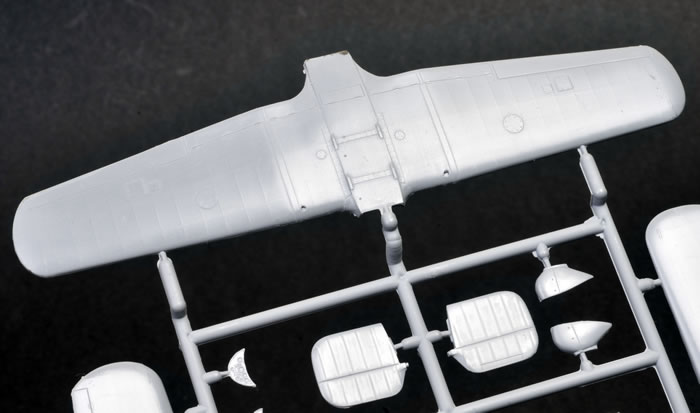
The cockpit is nicely detailed. The heel boards, control column and rudder mounting points are moulded into the lower wing. Separate internal side panels with structural detail fit into the lower sides of the fuselage and meet with the floor formed by the lower wing half. Two bulkheads form the rear of the student’s and instructor’s cockpits. Each has a nice bucket seat garnished with a PE harness. The very fine styrene control columns include the linkage between the two, whilst PE provides for the rudder bars. There is a choice of instrument panel media, being either nicely moulded 3D detail in styrene or PE with instruments printed on clear film. I welcome this choice as there are times where I find PE and film panels to be nightmares to use. This way, you can have a crack at getting the PE panels right and looking nice, or resort to the styrene parts if you fail. A PE compass repeater is also provided for each cockpit.
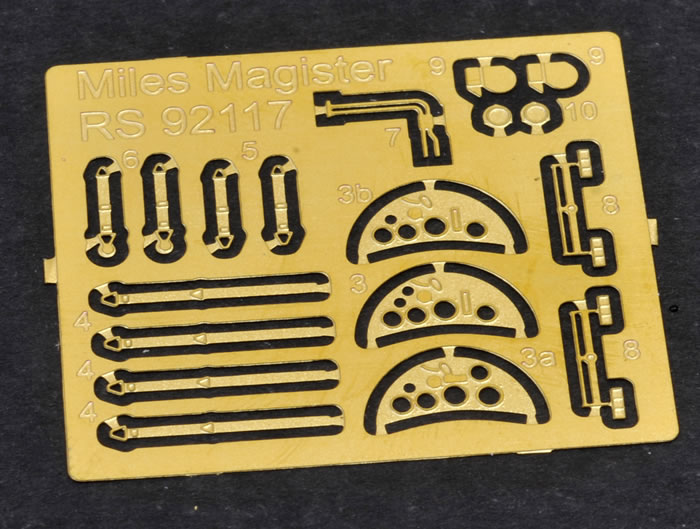
There are a couple of engine cylinders to insert behind the open engine air-cooling intake before closing the fuselage halves. Other fuselage details include an exhaust pipe, two venturi-type pitots, optional stowed blind-flying hood, windscreens that must be cut from the clear film and folded or curved as applicable, and of course a propeller and tail-wheel.
One decal option is for a single seat version where the rear cockpit is faired over and the headrest removed. A drawing is the only guide provided, as no mention is made of cutting the headrest off, or of the need to fabricate the cockpit cover for the rear cockpit. Ideally, an additional part to close the cockpit should have been provided, or at least a template to guide making of one from plastic sheet. Here is an RS Models image of the kit finished as the single-seat option:
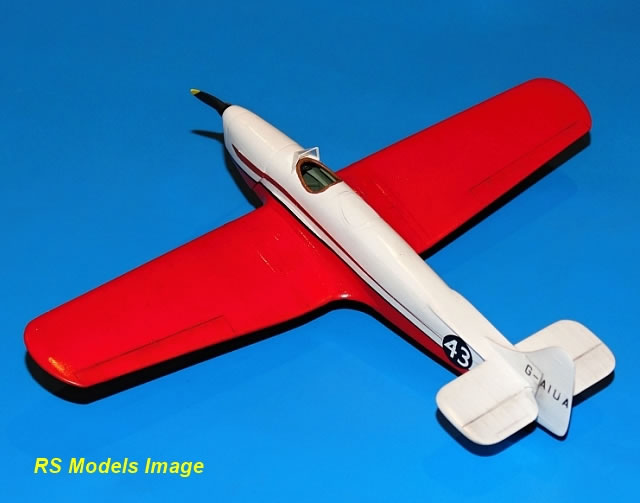
The wing joint should be quite strong because the lower half is one-piece. The wing trailing edges are fairly fine as supplied, but some will wish to carry out a bit of extra thinning. Very slender tabs and slots are included with the tailplane.
There is a choice of main undercarriage styles, either with spatted or exposed legs. Both use the same wheels, but in the case of the spats you will have to just insert the wheels to the right depth within the spats, as there are no axles or locating pins for them.
All that is left to mention is a PE pitot that mounts under the port wing, its mounting location being vaguely indicated in the instructions by an arrow. A head-on view on the last page of the instructions at least shows its location span-wise; whilst the box-art profile shows it to be located at about two thirds chord.
The sprues include eight tiny bombs and couple of panels not mentioned in the instructions.
Obviously, the single-seat option presents a bit more of a challenge to build than the other decal options because of its need for some simple cutting and fabrication. Aside from this I think the most difficult challenge will be forming the rear cockpit’s curved windshield, as I anticipate this will need to be dipped in hot water when tightly curled around a suitable rod. These points aside, I would expect this to build well for a limited run kit based on my experience of similar types by RS Models. The finished results are appealing as evidenced by this RS Model image of the finished model:
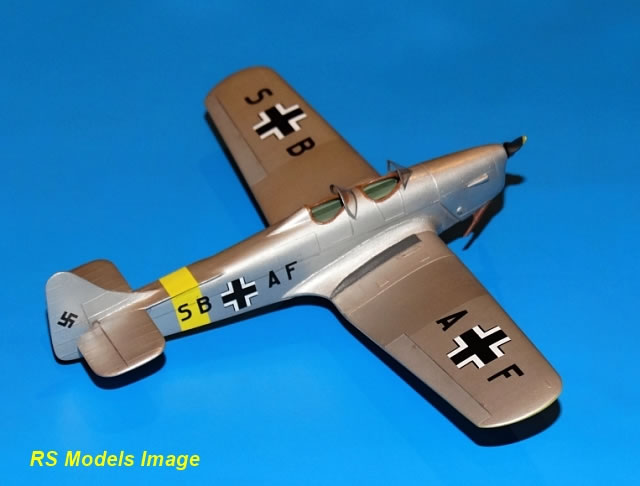
Colours & Markings
Four decal options are provided, these being:
-
Alexandria, Egypt, 1941.
-
G-AIJA Coventry Airfield, 1960.
-
Sonderstaffel Buchmann, Gulf of Finland, 1942
-
Turkish Air-Force Hava Okulu, 1st Training Battalion.
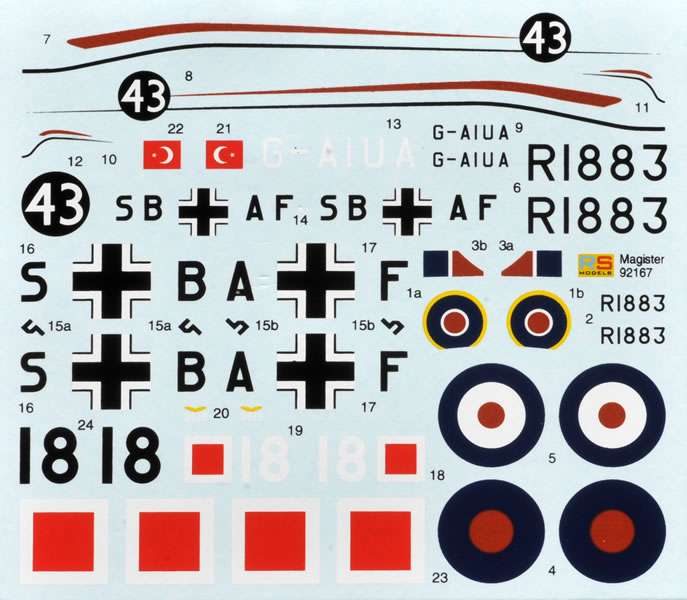
The decals appear excellent, and my prior experience of the brand would suggest that they should perform well. If the kit options do not appeal Kora & LF Models offer quite a selection of alternative aftermarket decal sheets.
This is a good quality limited run kit with some very nice surface detail. The components are nicely rendered and assembly is generally well catered for by the instructions, although the underwing pitot’s location could be made easier to discern than it is.
The option of single-seater is nice to have, but the inclusion of a cockpit blanking plate would have been nice, or at least a template to help make one should have been included. We tend to be tolerant of such omissions with limited run kits, but this does not excuse their manufacturers from improving what is provided. RS Models could have done better in this instance without much extra effort, especially when this boxing costs 20% more than the previous two issues.
Single-seater gripes aside, this is a delightful kit of the Miles Magister, and highly recommended.
Thanks to RS Models for the review sample
Review Text Copyright © 2015 by Mark Davies
Images Copyright © 2015 by Brett Green
Page Created 21 April, 2015
Last updated
22 April, 2015
Back to HyperScale Main Page
Back to Reviews Page

|
